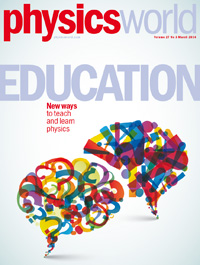By Matin Durrani
If there’s one thing that unites pretty much all of us who like physics, it’s that we’ve all sat through physics classes at some point in our lives. We all know teachers and lecturers who’ve been brilliant and inspired us, but equally we’ve all sat through classes that have quite frankly bored us out of our pants.

In the March 2014 issue of Physics World – a PDF copy of which you can download free of charge – we offer a snapshot of just some of the many innovative ideas that exist for learning and teaching physics. It’s not an exhaustive selection, but includes topics that we felt were interesting or novel.
So, download the issue to find out about the huge growth of “massive open online courses”, or MOOCs, in which universities make their lectures freely available in video form on the Internet, and discover Philip Moriarty’s behind-the-scenes experiences as one of the stars of the Sixty Symbols series of YouTube science videos.
Elsewhere, check out the great feature by BBC science presenter Fran Scott, who reveals her four golden rules for engaging children with science, and discover the importance of helping children develop computer-programming skills from an early age. Don’t miss out either on Eugenia Etkina and Gorazd Planinšič’s article on the implications for teachers of the fact that learning involves physical changes in the brain.
And if you’re a student who’s tired of writing notes in lectures, then how about drawing pictures instead? It’s a technique that professional “doodler” Perrin Ireland uses, and to show you how it works, we asked her to”doodle” notes for the video of a lecture given in 1964 by the inspirational Richard Feynman. We’ll never know, but my bet is he would have been amused.
Download your free copy of the March 2014 issue of Physics World now!
Don’t forget that if you want to read Physics World each month, you can do so through our digital edition, which can be accessed online or via our Apple and Android apps simply by becoming a member of the Institute of Physics. You can join the Institute as an IOPimember quickly and easily online. IOPimember includes an annual digital subscription to Physics World for just £15/€20/$25 per year. This month’s digital issue contains a heap of multimedia content, including some special videos on physics education. And by joining the Institute, you’re helping to support its many efforts to improve the quality of physics education. Go on – you know it’s worth it.
I am a retired high school physics teacher. I am also a retired engineer dealing with failure analysis. I may be retired but I am not done yet!
I couldn’t resist commenting. Very well written!
Love to think about new ways to teach and explain physics concepts. Although I am no longer a teacher I am working on collecting some of my thoughts and ideas about the subject.
“It’s not an exhaustive selection, but includes topics that we felt were interesting or novel”
I don’t agree: http://gettingsmart.com/2013/01/10-innovative-ways-to-use-thinglink-in-the-classroom/